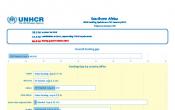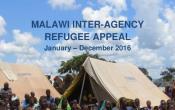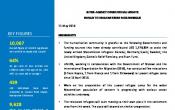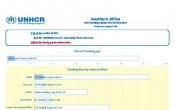Malawi
Operation: Malawi
Location
{"longitude":34,"latitude":-13,"zoom_level":0}
Latest update of camps and office locations 21 Nov 2016. By clicking on the icons on the map, additional information is displayed.
Key Figures
| 2016 end-year results | |
| 30,260 | people of concern received shelter support in Dzaleka and Luwani camps |
| 30,000 | people of concern and 40,000 people in host communities were provided with primary health services |
| 7,190 | refugee and asylum-seeker children were enrolled in primary education in Dzaleka and Luwani camps |
| 1,200 | people of concern had their cases submitted for resettlement |
| 2017 planning figures | |
| 2,100 | the average number of kilocalories distributed per person per day |
| 920 | latrines will be constructed in Dzaleka camp to reach the minimum standard of one latrine per 20 people and to ensure that people of concern live in satisfactory conditions of hygiene |
| 50% | or more of people of concern will have access to lighting, and all will have access to alternative fuel sources or renewable energy for their cooking needs |
| 30% | of primary school-aged children who are currently out of school will be enrolled in schools |
| 20% | of people of concern will be supported to undertake livelihoods activities |
Latest Updates
Last Updated 11 May 2016
People of Concern
29%
Increase in
2016
2016
| 2016 | 30,415 |
| 2015 | 23,489 |
| 2014 | 20,373 |

[["Refugees",9392],["Asylum-seekers",21023]]
Loading ...
Malawi
< Back
2016
{"categories":[2012,2013,2014,2015,2016,2017],"budget":[3.47565893,4.43871604,4.41194171,6.24625509,14.05602103,18.11807959],"expenditure":[2.47496269,2.73036648,2.94750217,3.7456183,5.68901108,null]}
{"categories":[2012,2013,2014,2015,2016,2017],"p1":[3.47565893,4.43871604,4.41194171,5.71283409,14.05602103,18.11807959],"p2":[null,null,null,null,null,null],"p3":[null,null,null,null,null,null],"p4":[null,null,null,0.533421,null,null]}
{"categories":[2012,2013,2014,2015,2016,2017],"p1":[2.47496269,2.73036648,2.94750217,3.26069035,5.68901108,null],"p2":[null,null,null,null,null,null],"p3":[null,null,null,null,null,null],"p4":[null,null,null,0.48492795,null,null]}
Loading ...
CHOOSE A YEAR
- 2015
- 2016
- 2017
Working environment
UNHCR continued to support the Government of Malawi on refugee status determination; the formulation of accelerated procedures to address the backlog; and in capacity building. The adoption of revised refugee policy and the amendment bill are pending approval.The Government’s decision to relocate refugees and asylum-seekers from Dzaleka camp to Katiri, Karonga district to implement a settlement model will increase access to livelihood opportunities for people of concern, such as in agriculture.
Malawi received an influx of some 10,000 Mozambican asylum-seekers in March 2016. A UNHCR-led inter-agency response was launched to coordinate activities and mobilize resources. A former refugee camp in Luwani was re-opened in April to accommodate the Mozambican asylum-seekers.
Population trends
- Malawi received 5,719 new arrivals, mostly from the Democratic Republic of the Congo (4,583), Rwanda (576) and Burundi (560).
- Dzaleka camp hosted 27,126 refugees and asylum-seekers.
- Luwani camp hosted 3,135 Mozambican asylum-seekers.
Achievements and impact
- An inter-agency response to manage the influx of Mozambican asylum-seekers was led by UNHCR in collaboration with partners.
- All people of concern are registered on an individual basis and their specific needs were taken into account. Identification of vulnerable persons of concern can now be done using registration data.
- Vulnerability assessments for people of concern with disabilities were conducted.
Unmet needs
- UNHCR faced challenges in meeting the basic and essential needs of refugees and asylum-seekers in Dzaleka camp, including as a result of infrastructure and service provision gaps due to an increase in the population of concern.
- Livelihood and self-reliance programmes were particularly impacted by underfunding.
- Some inter-agency partners in Luwani camp were unable to sustain their assistance.
Operational context and population trends
Malawi remains a stable country, with a new Government having been voted into power less than a year ago. However, in 2015 severe floods have caused displacement and food insecurity, posing a major challenge to the new Government.Malawi continues to receive refugees, although the Government intends to relocate the refugee camp from its current location to a place identified in the border town of Kasonga, over 620 kilometres away from the capital, Lilongwe. UNHCR will be called upon to identify additional resources to set up a new camp and transit centre.
The population of concern consists of refugees and asylum-seekers mainly from the Democratic Republic of the Congo (DRC). As long as the situation in the Eastern part of the DRC remains volatile, the refugee population in Malawi will continue to grow. Based on current trends, it is expected that the population will reach 29,000 individuals in December 2016. Only a modest number of asylum-seekers from the Horn of Africa and other countries such as Burundi and Rwanda are expected to arrive in Malawi.
Key priorities in 2016
- Strengthen good relations and partnerships with the Government;
- Prioritize resettlement, focusing on refugees with specific needs and vulnerabilities;
- Ensure that RSD procedures are functioning and enhanced through capacity building activities and technical support;
- Support the ongoing merging of the draft refugee policy and the development amendment bill;
- Continue to capacitate relevant government departments;
- Maintain the provision of drugs at Dzaleka health centre and ensure that people of concern have free access to primary health care and other national services;
- Ensure that food is distributed to all people of concern.





